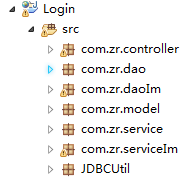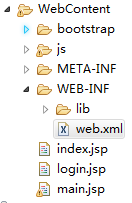MVC mode realizes login and login of adding, deleting, modifying and checking
I am not using a maven project here, I am using a general web project, so I need to download and add the framework packages I need to use. In the project, I must pay attention to the configuration of the environment. I am using jre1.7
1 Create a new project

2 Establish the MVC management package and import the corresponding rack package servlet

3 Create the entity class teacher.java corresponding to the database
public class Teacher {
private int tid;
private String tname;
private String tpsw;
public int getTid() {
return tid;
}
public void setTid(int tid) {
this.tid = tid;
}
public String getTname() {
return tname;
}
public void setTname(String tname) {
this.tname = tname;
}
public String getTpsw() {
return tpsw;
}
public void setTpsw(String tpsw) {
this.tpsw = tpsw;
}
public Teacher(String tname, String tpsw) {
super();
this.tname = tname;
this.tpsw = tpsw;
}
public Teacher(int tid, String tname, String tpsw) {
super();
this.tid = tid;
this.tname = tname;
this.tpsw = tpsw;
}
public Teacher() {
super();
}
}4 Write a new login.jsp file in WebContent Login box
1
2
5 Configure the web.xml file corresponding to the form request login

web .xml file
Note: When configuring,
<!-- 提交登录请求 -->
<servlet>
<servlet-name>login</servlet-name>
<servlet-class>com.zr.controller.LoginController</servlet-class>
</servlet>
<servlet-mapping>
<servlet-name>login</servlet-name>
<url-pattern>/login</url-pattern>
</servlet-mapping>6 Write the corresponding request entity class LoginController.java: Inherit HttpServlet and rewrite the doget(), dopost() methods, according to the different method requests Call the doget or dopost method
LoginController.java
import java.io.IOException;
import javax.servlet.ServletException;
import javax.servlet.http.HttpServlet;
import javax.servlet.http.HttpServletRequest;
import javax.servlet.http.HttpServletResponse;
import javax.servlet.http.HttpSession;
import com.zr.model.Teacher;
import com.zr.service.valiDateService;
import com.zr.serviceIm.valiDateServiceImpl;
public class LoginController extends HttpServlet{
protected void doGet(HttpServletRequest req, HttpServletResponse resp)
throws ServletException, IOException {
super.doPost(req, resp);
}
protected void doPost(HttpServletRequest req, HttpServletResponse resp)
throws ServletException, IOException {
//获取前台form表单的input输入框
String tname=req.getParameter("tname");
String tpsw=req.getParameter("tpsw");
Teacher tc=new Teacher();
tc.setTname(tname);
tc.setTpsw(tpsw);
valiDateService vds=new valiDateServiceImpl();
Teacher t= vds.valiDateTeacher(tc);
HttpSession session=req.getSession();
session.setAttribute("teacher", t);
if (t!=null) {
//返回的不是空值,重定向到登录成功界面
req.getRequestDispatcher("main.jsp").forward(req, resp);
} else {
//返回空值,请求转发到登录界面
resp.sendRedirect("login.jsp");
}
}
}7 Write from the background dao layer to the control layer
public interface TeacherDao {
/**
* 验证老师是否存在
* @param tc
* @return
*/
public Teacher validateTeacher(Teacher tc);
}8.1 Write the encapsulation class to establish the connection with the database JDBCUtil.java
package JDBCUtil;
import java.sql.Connection;
import java.sql.DriverManager;
import java.sql.SQLException;
import java.sql.Statement;
public class JDBCUtil {
//1.数据库地址 (根据不同的数据标准是不一样)
private final static String DBURL = "jdbc:mysql://localhost:3306/student_crm?useUnicode=true&characterEncoding=UTF8";
//2.设置用户和密码
private final static String USERNAME = "root";
private final static String PASSWORD = "root";
//3.设置驱动名称 (根据不同的数据标准是不一样)
private final static String DBDRIVER = "com.mysql.jdbc.Driver";
/**
* 获取数据库连接
* @return 返回数据库连接
*/
public static Connection getConnection(){
Connection con = null;
try {
Class.forName(DBDRIVER);
con = DriverManager.getConnection(DBURL, USERNAME, PASSWORD);
} catch (ClassNotFoundException e) {
// TODO Auto-generated catch block
e.printStackTrace();
} catch (SQLException e) {
// TODO Auto-generated catch block
e.printStackTrace();
}
return con;
}
//关闭连接
public static void closeJDBC(Statement st,Connection con) throws SQLException{
if(st!=null){
st.close();
}
if(con!=null){
con.close();
}
}
}8.2 Implementation of the dao layer
import java.sql.Connection;
import java.sql.PreparedStatement;
import java.sql.ResultSet;
import java.sql.SQLException;
import com.zr.dao.TeacherDao;
import com.zr.model.Teacher;
import JDBCUtil.JDBCUtil;
public class TeacherDaoImpl implements TeacherDao{
/**
* 输入老师的对象,返回老师对象
* @param args
*/
public Teacher validateTeacher(Teacher tc) {
Teacher teacher=new Teacher();
//sql语句
StringBuffer sql=new StringBuffer("select * from teacher where tname=? and tpsw=?");
//获取数据库连接
Connection con=JDBCUtil.getConnection();
try {
PreparedStatement pst=con.prepareStatement(sql.toString());
pst.setString(1, tc.getTname());
pst.setString(2, tc.getTpsw());
//返回一个结果集
ResultSet rs=pst.executeQuery();
if (rs.next()) {
//把结果集里面的数据放入对应的teacher对象
teacher=new Teacher(rs.getInt("tid"),rs.getString("tname"),rs.getString("tpsw"));
}
} catch (SQLException e) {
e.printStackTrace();
}
return teacher;
}
}9 Service Layer
public interface valiDateService {
/**
* @param tc
* @return 老师对象
* 根据用户输入值验证老师是否存在
*/
public Teacher valiDateTeacher(Teacher tc);
}10 Service layer implements ServiceImpl.java
import com.zr.dao.TeacherDao;
import com.zr.daoIm.TeacherDaoImpl;
import com.zr.model.Teacher;
import com.zr.service.valiDateService;
public class valiDateServiceImpl implements valiDateService{
public Teacher valiDateTeacher(Teacher tc) {
//父类的引用指向子类的对象,父类可以直接调用子类的方法
TeacherDao teacherDao=new TeacherDaoImpl();
//调用dao层的方法验证存在
Teacher teacher=teacherDao.validateTeacher(tc);
return teacher;
}
}11 com.zr.controller layer
import java.io.IOException;
import javax.servlet.ServletException;
import javax.servlet.http.HttpServlet;
import javax.servlet.http.HttpServletRequest;
import javax.servlet.http.HttpServletResponse;
import javax.servlet.http.HttpSession;
import com.zr.model.Teacher;
import com.zr.service.valiDateService;
import com.zr.serviceIm.valiDateServiceImpl;
public class LoginController extends HttpServlet {
protected void doGet(HttpServletRequest req, HttpServletResponse resp) throws ServletException, IOException {
super.doPost(req, resp);
}
protected void doPost(HttpServletRequest req, HttpServletResponse resp) throws ServletException, IOException {
// 获取前台form表单的input输入框
String tname = req.getParameter("tname");
String tpsw = req.getParameter("tpsw");
// 将前台对象放入tc对象,作为输入参数
Teacher tc = new Teacher();
tc.setTname(tname);
tc.setTpsw(tpsw);
// 调用Service层的方法传入tc对象,并用t接收返回结果
valiDateService vds = new valiDateServiceImpl();
Teacher t = vds.valiDateTeacher(tc);
// 获取JSP作用域session,将老师t对象放入session
HttpSession session = req.getSession();
int a = t.getTid();//最好根据返回的老师的id进行判断
if (a != 0) {
// 返回的有id,重定向到登录成功界面
req.getRequestDispatcher("main.jsp").forward(req, resp);
session.setAttribute("teacher", t);
} else {
// 返回空值,请求转发到登录界面
req.getRequestDispatcher("login.jsp").forward(req, resp);
}
}
}
Hot AI Tools

Undresser.AI Undress
AI-powered app for creating realistic nude photos

AI Clothes Remover
Online AI tool for removing clothes from photos.

Undress AI Tool
Undress images for free

Clothoff.io
AI clothes remover

Video Face Swap
Swap faces in any video effortlessly with our completely free AI face swap tool!

Hot Article

Hot Tools

Notepad++7.3.1
Easy-to-use and free code editor

SublimeText3 Chinese version
Chinese version, very easy to use

Zend Studio 13.0.1
Powerful PHP integrated development environment

Dreamweaver CS6
Visual web development tools

SublimeText3 Mac version
God-level code editing software (SublimeText3)

Hot Topics
 1657
1657
 14
14
 1415
1415
 52
52
 1309
1309
 25
25
 1257
1257
 29
29
 1229
1229
 24
24
 PHP MVC Architecture: Building Web Applications for the Future
Mar 03, 2024 am 09:01 AM
PHP MVC Architecture: Building Web Applications for the Future
Mar 03, 2024 am 09:01 AM
Introduction In today's rapidly evolving digital world, it is crucial to build robust, flexible and maintainable WEB applications. The PHPmvc architecture provides an ideal solution to achieve this goal. MVC (Model-View-Controller) is a widely used design pattern that separates various aspects of an application into independent components. The foundation of MVC architecture The core principle of MVC architecture is separation of concerns: Model: encapsulates the data and business logic of the application. View: Responsible for presenting data and handling user interaction. Controller: Coordinates the interaction between models and views, manages user requests and business logic. PHPMVC Architecture The phpMVC architecture follows the traditional MVC pattern, but also introduces language-specific features. The following is PHPMVC
 An advanced guide to PHP MVC architecture: unlocking advanced features
Mar 03, 2024 am 09:23 AM
An advanced guide to PHP MVC architecture: unlocking advanced features
Mar 03, 2024 am 09:23 AM
The MVC architecture (Model-View-Controller) is one of the most popular patterns in PHP development because it provides a clear structure for organizing code and simplifying the development of WEB applications. While basic MVC principles are sufficient for most web applications, it has some limitations for applications that need to handle complex data or implement advanced functionality. Separating the model layer Separating the model layer is a common technique in advanced MVC architecture. It involves breaking down a model class into smaller subclasses, each focusing on a specific functionality. For example, for an e-commerce application, you might break down the main model class into an order model, a product model, and a customer model. This separation helps improve code maintainability and reusability. Use dependency injection
 Uncovering the success of the SpringMVC framework: why it is so popular
Jan 24, 2024 am 08:39 AM
Uncovering the success of the SpringMVC framework: why it is so popular
Jan 24, 2024 am 08:39 AM
SpringMVC framework decrypted: Why is it so popular, specific code examples are needed Introduction: In today's software development field, the SpringMVC framework has become a very popular choice among developers. It is a Web framework based on the MVC architecture pattern, providing a flexible, lightweight, and efficient development method. This article will delve into the charm of the SpringMVC framework and demonstrate its power through specific code examples. 1. Advantages of SpringMVC framework Flexible configuration method Spr
 How to implement the MVC pattern using PHP
Jun 07, 2023 pm 03:40 PM
How to implement the MVC pattern using PHP
Jun 07, 2023 pm 03:40 PM
The MVC (Model-View-Controller) pattern is a commonly used software design pattern that can help developers better organize and manage code. The MVC pattern divides the application into three parts: Model, View and Controller, each part has its own role and responsibilities. In this article, we will discuss how to implement the MVC pattern using PHP. Model A model represents an application's data and data processing. usually,
 How to implement scalable MVC architecture in PHP8 framework
Sep 11, 2023 pm 01:27 PM
How to implement scalable MVC architecture in PHP8 framework
Sep 11, 2023 pm 01:27 PM
How to implement a scalable MVC architecture in the PHP8 framework Introduction: With the rapid development of the Internet, more and more websites and applications adopt the MVC (Model-View-Controller) architecture pattern. The main goal of MVC architecture is to separate different parts of the application in order to improve the maintainability and scalability of the code. In this article, we will introduce how to implement a scalable MVC architecture in the PHP8 framework. 1. Understand the MVC architecture pattern. The MVC architecture pattern is a software design
 How to use MVC architecture to design projects in PHP
Jun 27, 2023 pm 12:18 PM
How to use MVC architecture to design projects in PHP
Jun 27, 2023 pm 12:18 PM
In Web development, MVC (Model-View-Controller) is a commonly used architectural pattern for processing and managing an application's data, user interface, and control logic. As a popular web development language, PHP can also use the MVC architecture to design and build web applications. This article will introduce how to use MVC architecture to design projects in PHP, and explain its advantages and precautions. What is MVCMVC is a software architecture pattern commonly used in web applications. MV
 Developing MVC with PHP8 framework: Important concepts and techniques that beginners need to know
Sep 11, 2023 am 09:43 AM
Developing MVC with PHP8 framework: Important concepts and techniques that beginners need to know
Sep 11, 2023 am 09:43 AM
Developing MVC with PHP8 framework: Important concepts and techniques that beginners need to know Introduction: With the rapid development of the Internet, Web development plays an important role in today's software development industry. PHP is widely used for web development, and there are many mature frameworks that help developers build applications more efficiently. Among them, the MVC (Model-View-Controller) architecture is one of the most common and widely used patterns. This article will introduce how beginners can use the PHP8 framework to develop MVC applications.
 Revealing the secrets of PHP MVC architecture: Make your website fly
Mar 03, 2024 am 09:25 AM
Revealing the secrets of PHP MVC architecture: Make your website fly
Mar 03, 2024 am 09:25 AM
Model-view-controller (mvc) architecture is a powerful design pattern for building maintainable and scalable WEB applications. The PHPMVC architecture decomposes application logic into three distinct components: Model: represents the data and business logic in the application. View: Responsible for presenting data to users. Controller: Acts as a bridge between the model and the view, handling user requests and coordinating other components. Advantages of MVC architecture: Code separation: MVC separates application logic from the presentation layer, improving maintainability and scalability. Reusability: View and model components can be reused across different applications, reducing code duplication. Performance Optimization: MVC architecture allows caching of view and model results, thus increasing website speed. Test Friendly: Detachment




